Recommended

REPORTS
Recent forecasts for economic growth around the world place Latin America as the developing region with the lowest growth rate, a dubious distinction it has earned in six of the last ten years. For example, the IMF and the World Bank forecast a meager rate of growth for Latin America in 2023—1.8 and 1.3 percent, respectively—with little improvement for 2024. Discouragingly, these poor outcomes coincide with a period of high commodity prices, which in the past have enhanced growth in the region.
How concerned should we be by these numbers? Very, and not only because the latest figures are just one more data point in a persistent trend. The numbers are also worrisome because key fundamentals reveal that the region has fallen into a “stagnation trap,” meaning there are no convincing reasons to believe that faster growth is in the cards in the foreseeable future.
Low growth rates and the reversal of convergence towards higher income levels
Over the last decade, the region grew at an annual average rate of 1.23 percent. Even excluding the 2020-21 pandemic period, the average growth rate remained extremely low at 1.6 percent. For comparison, during the so-called lost decade for Latin America, the region grew at an average rate of 2.2 percent.
These numbers suggest that Latin America not only stopped growing but also reversed its process of convergence to the per capita income levels of advanced economies. The recent evolution of income convergence can be approximated using IMF data on real GDP per capita adjusted for purchasing power parity. As shown in Figure 1, during the 2000s, Latin America started to converge to the per capita income of advanced economies. That process, however, did not last long and by 2012 it had started to reverse. By 2019, the year before the pandemic hit, Latin America’s income gap compared to advanced economies was back to where it was two decades earlier! In contrast, the aggregate group of emerging and developing countries (which includes the poorest countries in the world) started the process of convergence in the early 1990s and continues to date. (A sound analysis of convergence for the group of emerging and developing countries can be found in Patel, Sandefur and Subramanian, 2021). In the 1980s, Latin America’s income per capita was three times that of the entire group of emerging and developing countries; today, that difference has been reduced to less than 30 percent.
Figure 1. GDP per capita relative to advanced economies (adjusted for PPP) 1980 = 100
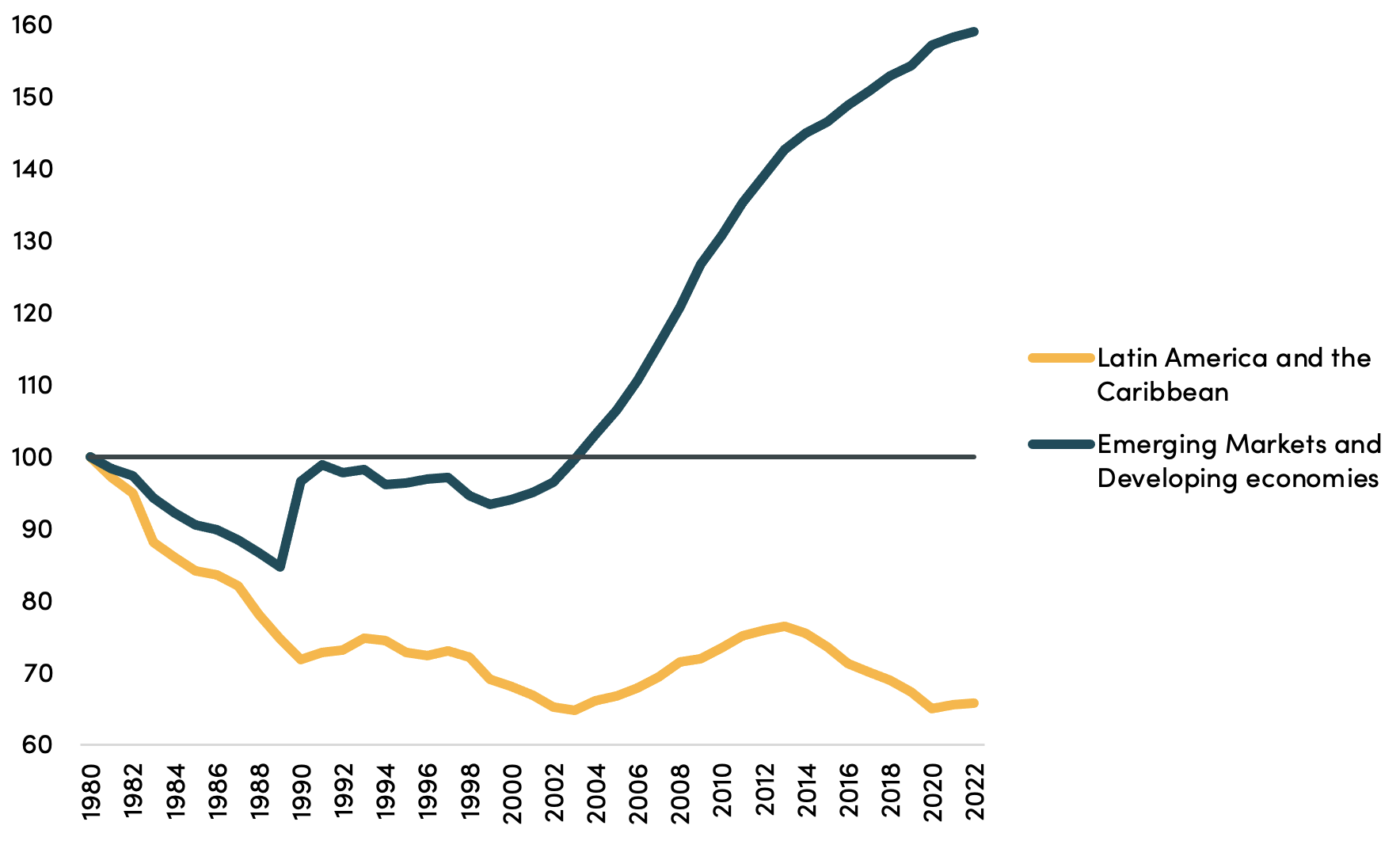
Source: Own calculations based on IMF data
Even more worrisome are the prospects that Latin America’s stagnation problem will be resolved anytime soon. Leaving aside the highly uncertain international financial conditions, which are important determinants of short-term growth, the local motors of growth are quite dysfunctional, constraining long-term growth. Two interrelated factors that were present in the pre-COVID period but intensified during the pandemic stand out: the deteriorating quality of governance and democratic institutions, and the high and increasing degree of labor and firm informality.
Increasing deterioration of governance and institutions
The World Bank Governance Indicators shows that for a number of countries in the region, key indicators of institutional quality, such as adherence to the rule of law, control of corruption, and political stability, deteriorated in the last decade. This is consistent with the findings of The Economist’s 2022 Democracy Index, which scores countries in five categories: electoral process and pluralism; civil liberties; the functioning of government; political participation; and political culture. The 2022 index states that in terms of democratic quality, Latin America “continues its recent decline,” with some countries like Mexico and El Salvador showing significant deterioration. (Figure 2)
Figure 2. Democracy Index in Latin America
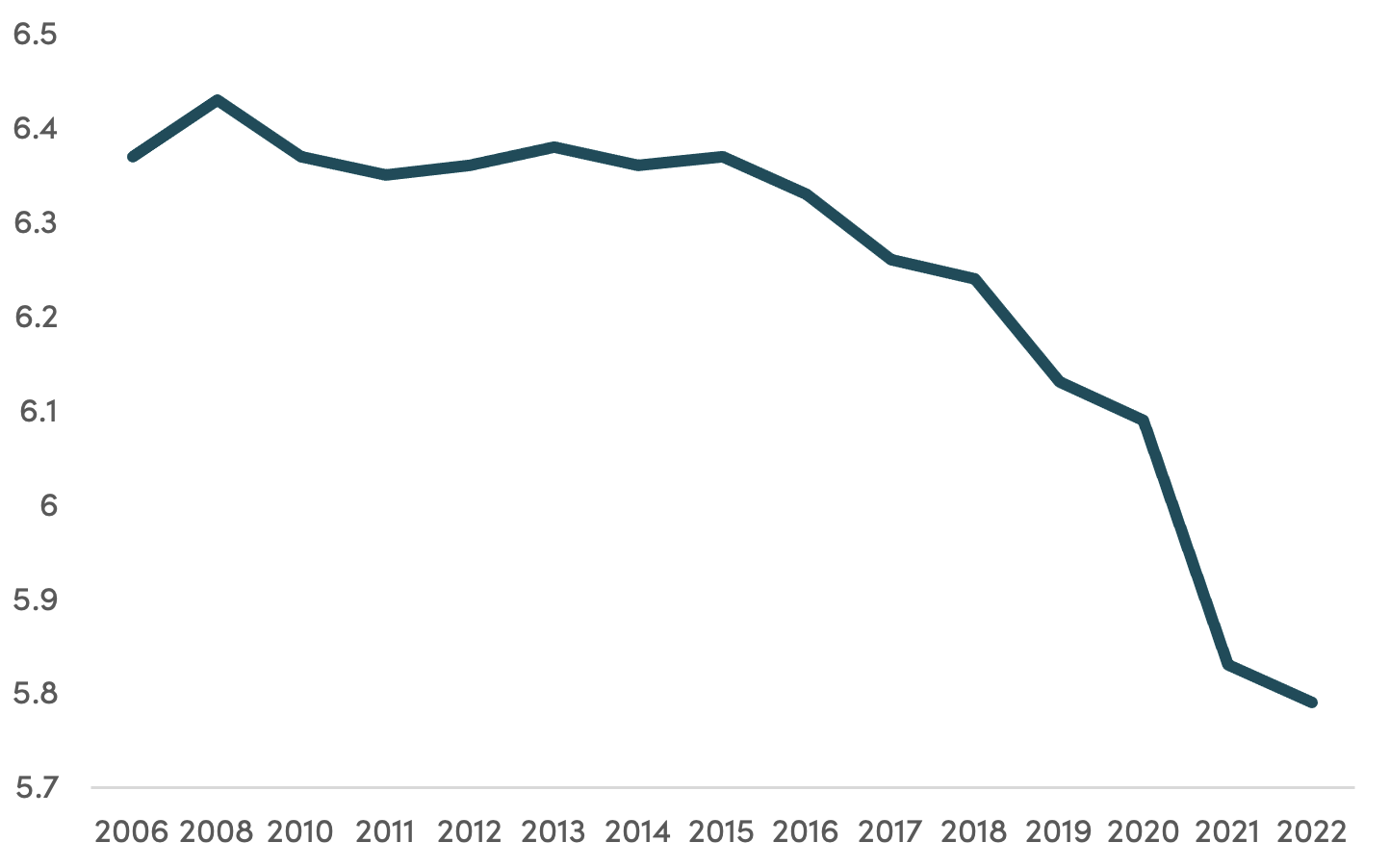
Survey data from Latinobarometro offer further evidence of severe institutional weaknesses in the region:
-
Trust in governments and their institutions is among the lowest in the world. For example:
- only 13 percent of the Latin American population has some trust in political parties
- only 36 percent of the population trust the police
-
70 percent of the population is not satisfied with the workings of democracy
-
The systems of political parties are highly fragmented with some countries, including Brazil and Peru, having more than 20 political parties
The number of government officials criminally charged in the region has skyrocketed in recent years, reflecting the deep institutional problems, including the prevalence of corruption. Perhaps the most alarming figure is that 20 presidents from 11 Latin American countries are either in jail or under judicial investigation.
The sustained weakening of democracies and their institutions does not bode well for investment and growth, as it conveys increasing uncertainty about the rules of the game under which local and foreign investors operate. Moreover, lack of trust in public institutions permeates into low trust between citizens, affecting their willingness to engage in private contracts necessary to conduct economic activities because of strong perceptions that enforcement of those contracts is not guaranteed.
Productivity is weak and increased informality doesn’t help
For several years now, low labor productivity has been a key obstacle to economic growth. As analyzed in Dieppe (2021), labor productivity in Latin America before the pandemic was below other emerging markets across different economic sectors. Contributing factors include high levels of informality, partly explained by distortionary policies, especially related to labor regulation, but also the weakening of institutions discussed above, including the low level of government effectiveness. Weak institutions constrain the provision of high-quality public goods and social insurance, and, therefore, reduce workers’ incentives to participate in formal labor markets.
The impressive levels of high informality in the region are shown in Figure 3. Labor informality reaches over 70 percent of total workers in a number of countries, with the median for the region at 63 percent. Only in Chile and Uruguay is labor informality below 30 percent.
Figure 3. Labor informality in Latin America (workers in the informal sector as a proportion of total employment)
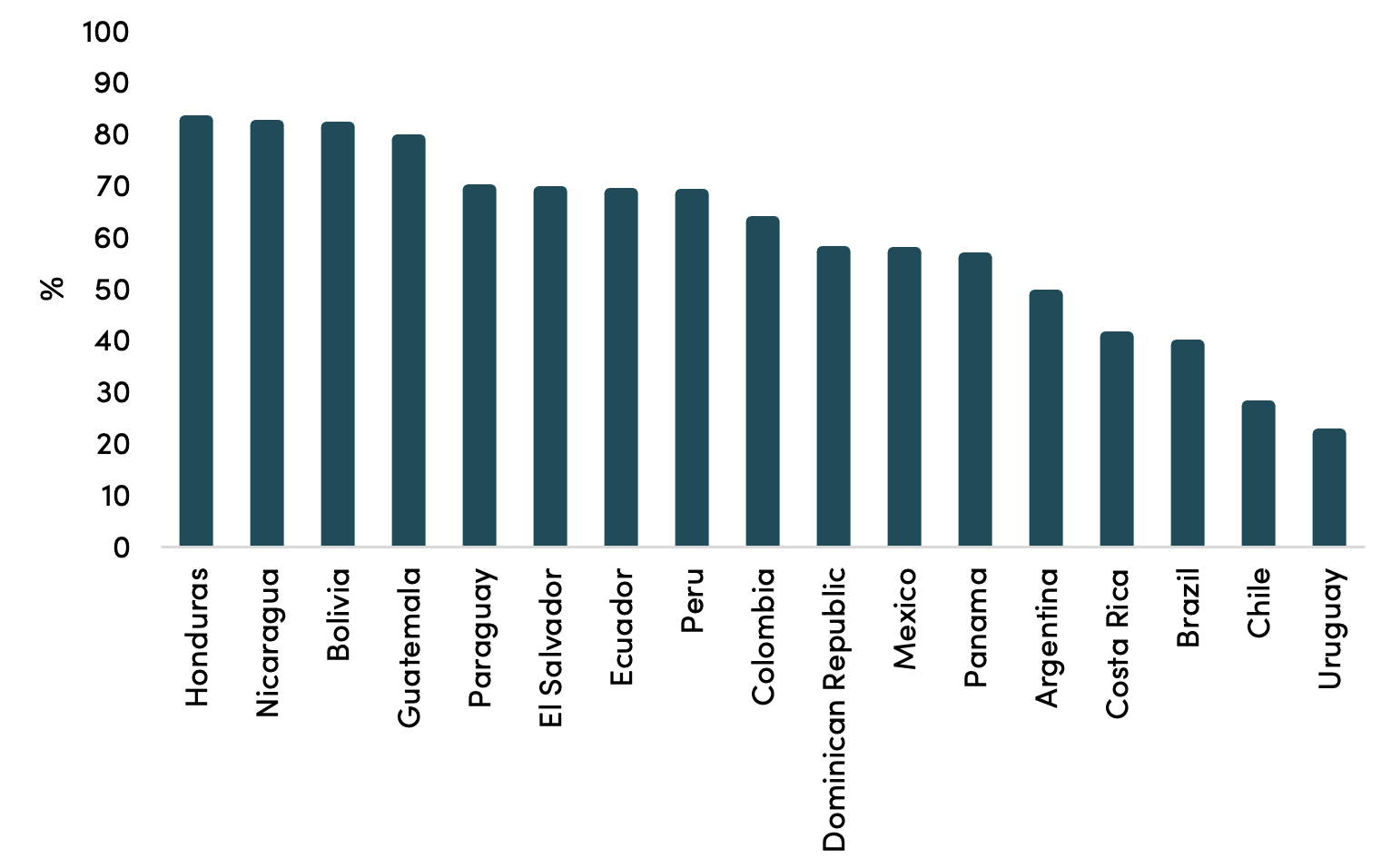
Source: ILOSTAT
In a number of countries—Peru, most notably—the pandemic and accompanying lockdowns drove informality levels even higher. Moreover, given current uncertainties, the risks for increasing informality are rising in the region. Recent data from the International Labour Organization indicate that, among 11 countries with available data, by the end of 2021 one in every two new jobs created was informal. High levels of informality with risks tilted towards further deterioration are a severe constraint for improvements in productivity and, therefore, for getting out of the stagnation trap.
Escaping the stagnation trap
Of course, a dark horizon on economic growth is not inevitable. The region has incredible potential. For example, it contains 60 percent of the world’s lithium reserves (a mineral key to the global energy transformation) and there has been significant progress in digitalization. Most importantly, regardless of political orientation, most countries remain committed to maintaining macroeconomic stability, which is a key foundation for sustained and equitable economic growth. However, for the region to realize its potential, significant governance improvements are a must. These improvements require difficult reforms, such as those to legislative and judiciary systems as well as those to revamp state capacity. So far, such reforms have proven extremely hard to implement in most countries. The million dollars question is, can consensus on reforms be reached in Latin America's highly polarized economies? Unquestionably, this is the top challenge for the region.
Nayke Montgomery was responsible for data collection, analysis and visualization, and research background, as well as Spanish translation.
Recientes proyecciones de crecimiento económico en todo el mundo colocan a América Latina como la región en desarrollo con la tasa de crecimiento más baja, una distinción dudosa que ha obtenido en seis de los últimos diez años. Por ejemplo, el FMI y el Banco Mundial pronostican una tasa de crecimiento modesta para América Latina en 2023, del 1.8 y 1.3 por ciento respectivamente, con poca mejora para 2024. Desalentadoramente, estos pobres resultados coinciden con un período de altos precios de las materias primas, que en el pasado han apoyado el crecimiento en la región.
¿Qué tan preocupados deberíamos estar por estos números? Mucho, y no solo porque las últimas cifras agreguen más datos a una tendencia persistente. Los números también son preocupantes porque los fundamentos económicos revelan que la región ha caído en una "trampa de estancamiento", lo que significa que no hay razones convincentes para creer que la región crezca más rápidamente en el futuro previsible.
Bajas tasas de crecimiento y reversión de la convergencia hacia niveles de ingresos más altos
Durante la última década, la región creció a una tasa promedio anual del 1.23 por ciento. Incluso excluyendo el período de pandemia 2020-21, la tasa de crecimiento promedio permaneció extremadamente baja en un 1.6 por ciento. Para comparar, durante la llamada década perdida de América Latina, la región creció a una tasa promedio del 2.2 por ciento.
Estos números sugieren que América Latina no solo dejó de crecer, sino que también revirtió su proceso de convergencia hacia los niveles de ingreso per cápita de las economías avanzadas. La evolución reciente del proceso de convergencia se puede aproximar utilizando los datos del FMI sobre el PIB real per cápita ajustado por paridad de poder adquisitivo. Como se muestra en la Figura 1, durante la década del 2000, América Latina comenzó a converger hacia el ingreso per cápita de las economías avanzadas. Sin embargo, ese proceso no duró mucho y en 2012 comenzó a revertirse. Para 2019, el año anterior antes de la pandemia, ¡la brecha de ingresos de América Latina en comparación con las economías avanzadas había vuelto al nivel de hace dos décadas! En contraste, el grupo agregado de países emergentes y en desarrollo (que incluye a los países más pobres del mundo) inició el proceso de convergencia a principios de la década de 1990 y continúa hasta la fecha. (Un análisis sólido de la convergencia para el grupo de países emergentes y en desarrollo se puede encontrar en Patel, Sandefur y Subramanian, 2021). En la década de 1980, el ingreso per cápita de América Latina era tres veces mayor que el de todo el grupo de países emergentes y en desarrollo; hoy en día, esa diferencia se ha reducido a menos del 30 por ciento.
Figura 1. PIB per cápita relativo a economías avanzandas (ajustado por PPA) 1980 = 100
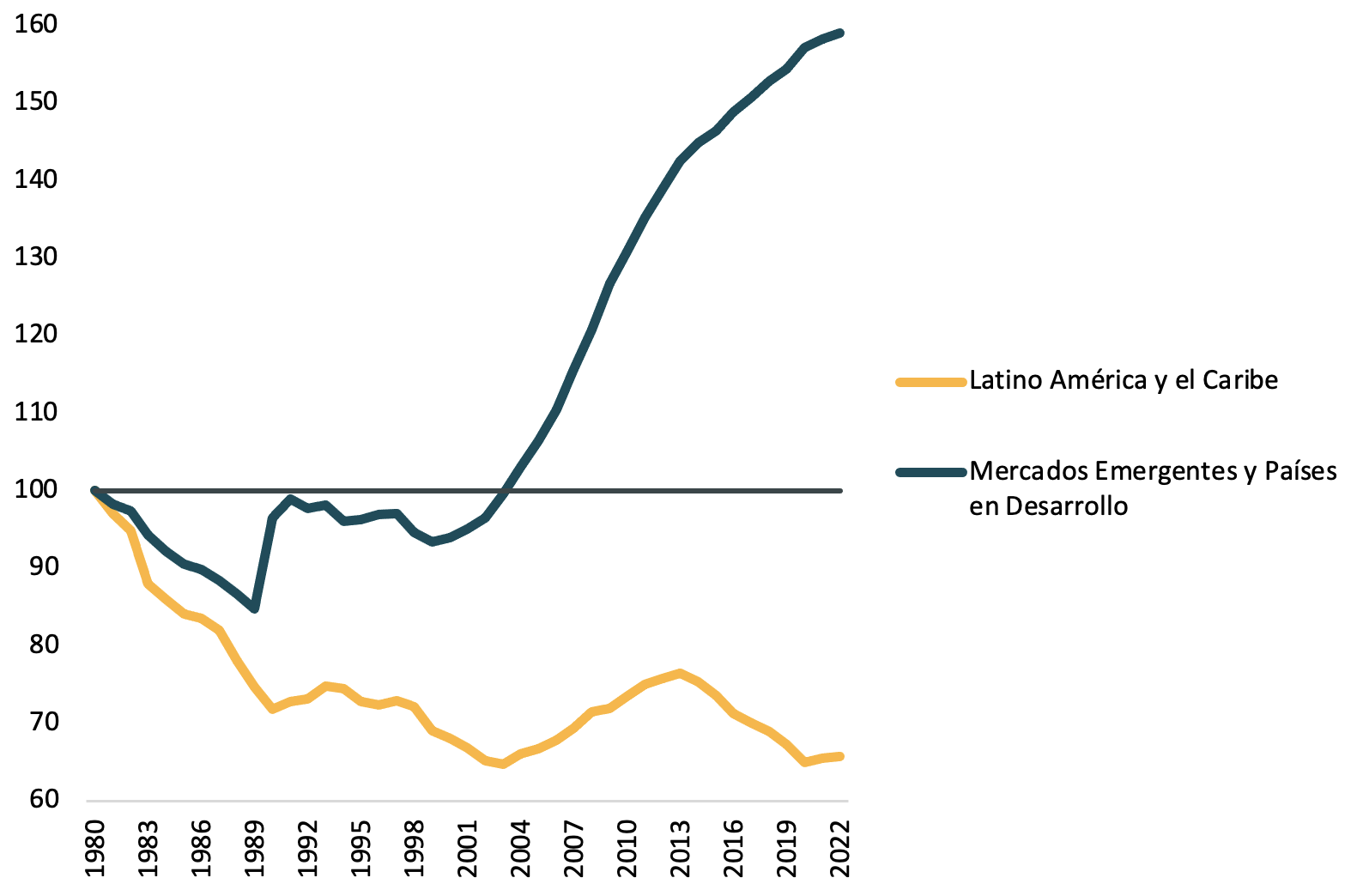
Fuente: Elaboración propia basada en los datos del FMI
Aún más preocupante es que no se visualiza que el problema de estancamiento de América Latina se pueda resolver en un futuro cercano. Dejando de lado las condiciones financieras internacionales altamente inciertas, que son importantes determinantes del crecimiento a corto plazo, los motores locales de crecimiento son bastante disfuncionales, lo que limita el crecimiento a largo plazo. Dos factores interrelacionados que destacan y estuvieron presentes en el período previo al COVID-19 pero que se intensificaron durante la pandemia son: el deterioro de la calidad de la gobernabilidad y las instituciones democráticas y el alto y creciente grado de informalidad laboral y empresarial.
Mayor deterioro de la gobernabilidad y las instituciones
Los Indicadores de Gobernabilidad del Banco Mundial muestran que, para varios países de la región, indicadores clave de calidad institucional, como la adherencia al Estado de derecho, el control de la corrupción y la estabilidad política, se han deteriorado en la última década. Esto coincide con los hallazgos del Índice de Democracia 2022 de The Economist, que califica a los países en cinco categorías: proceso electoral y pluralismo, libertades civiles, funcionamiento del gobierno, participación política y cultura política. El índice de 2022 indica que, en términos de calidad democrática, América Latina "continúa su declive", con algunos países como México y El Salvador mostrando un deterioro significativo. (Figura 2)
Figura 2. Índice de Democracia en América Latina
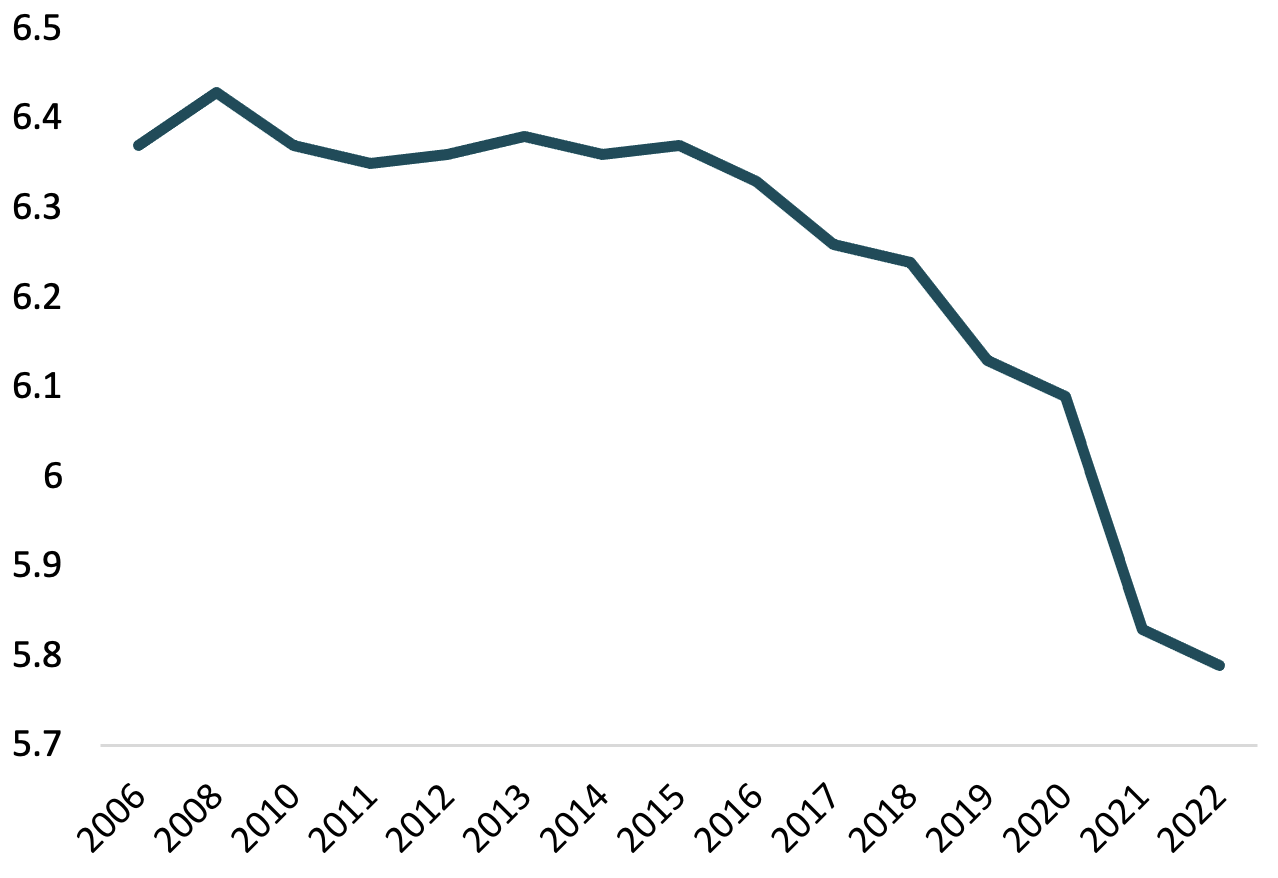
Los datos de encuestas del Latinobarometro corroboran las graves debilidades institucionales en la región:
- La confianza en los gobiernos y sus instituciones se encuentra entre las más bajas del mundo. Por ejemplo:
- solo el 13 por ciento de la población latinoamericana confía en los partidos políticos
- solo el 36 por ciento de la población confía en la policía
- El 70 por ciento de la población no está satisfecha con el funcionamiento de la democracia.
- Los sistemas de partidos políticos están altamente fragmentados, y en algunos países, incluyendo Brasil y Perú, existen más de 20 partidos políticos.
El número de funcionarios de gobierno acusados penalmente en la región ha aumentado drásticamente en los últimos años, lo que refleja los profundos problemas institucionales, incluida la prevalencia de la corrupción. Quizás la cifra más alarmante es que 20 presidentes de 11 países latinoamericanos están en la cárcel o bajo investigación judicial.
El debilitamiento sostenido de las democracias y sus instituciones no augura un buen futuro para la inversión y el crecimiento, ya que aumenta la incertidumbre sobre las reglas del juego bajo las cuales operan los inversionistas locales y extranjeros. Además, la falta de confianza en las instituciones públicas se impregna en la baja confianza entre los ciudadanos, lo que afecta su disposición a participar en contratos privados necesarios para llevar a cabo actividades económicas debido a la fuerte percepción de que el respeto de esos contratos no está garantizado.
La productividad es débil y el aumento de la informalidad no ayuda
Durante varios años, la baja productividad laboral ha sido un obstáculo clave para el crecimiento económico. Según el análisis de Dieppe (2021), la productividad laboral en América Latina antes de la pandemia estaba por debajo de otros mercados emergentes en la mayoría de sectores económicos. Los factores que contribuyen son altos niveles de informalidad, parcialmente explicados por políticas distorsionadoras, especialmente relacionadas con la regulación laboral, pero también por la debilidad institucional mencionada anteriormente, incluyendo el bajo nivel de eficacia del gobierno. Las instituciones débiles limitan la provisión de bienes públicos de alta calidad y de aseguramiento social, y, por lo tanto, reducen los incentivos de los trabajadores para participar en mercados laborales formales.
Los impresionantes niveles de alta informalidad en la región se muestran en la Figura 3. La informalidad laboral alcanza más del 70 por ciento de los trabajadores totales en varios países, con una mediana para la región del 63 por ciento. Solo en Chile y Uruguay la informalidad laboral es inferior al 30 por ciento.
En varios países, especialmente en Perú, la pandemia y los confinamientos aumentaron los niveles de informalidad. Además, dada la incertidumbre actual, los riesgos de una mayor informalidad están aumentando en la región. Datos recientes de la Organización Internacional del Trabajo indican que, en 11 países con datos disponibles, al final de 2021 uno de cada dos nuevos empleos creados era informal. Los altos niveles de informalidad con riesgos inclinados hacia un deterioro adicional son una severa restricción para las mejoras en la productividad y, por lo tanto, para salir de la trampa de estancamiento.
Figura 3. Informalidad Laboral en América Latina (trabajadores en el sector formal como porcentaje del empleo total)
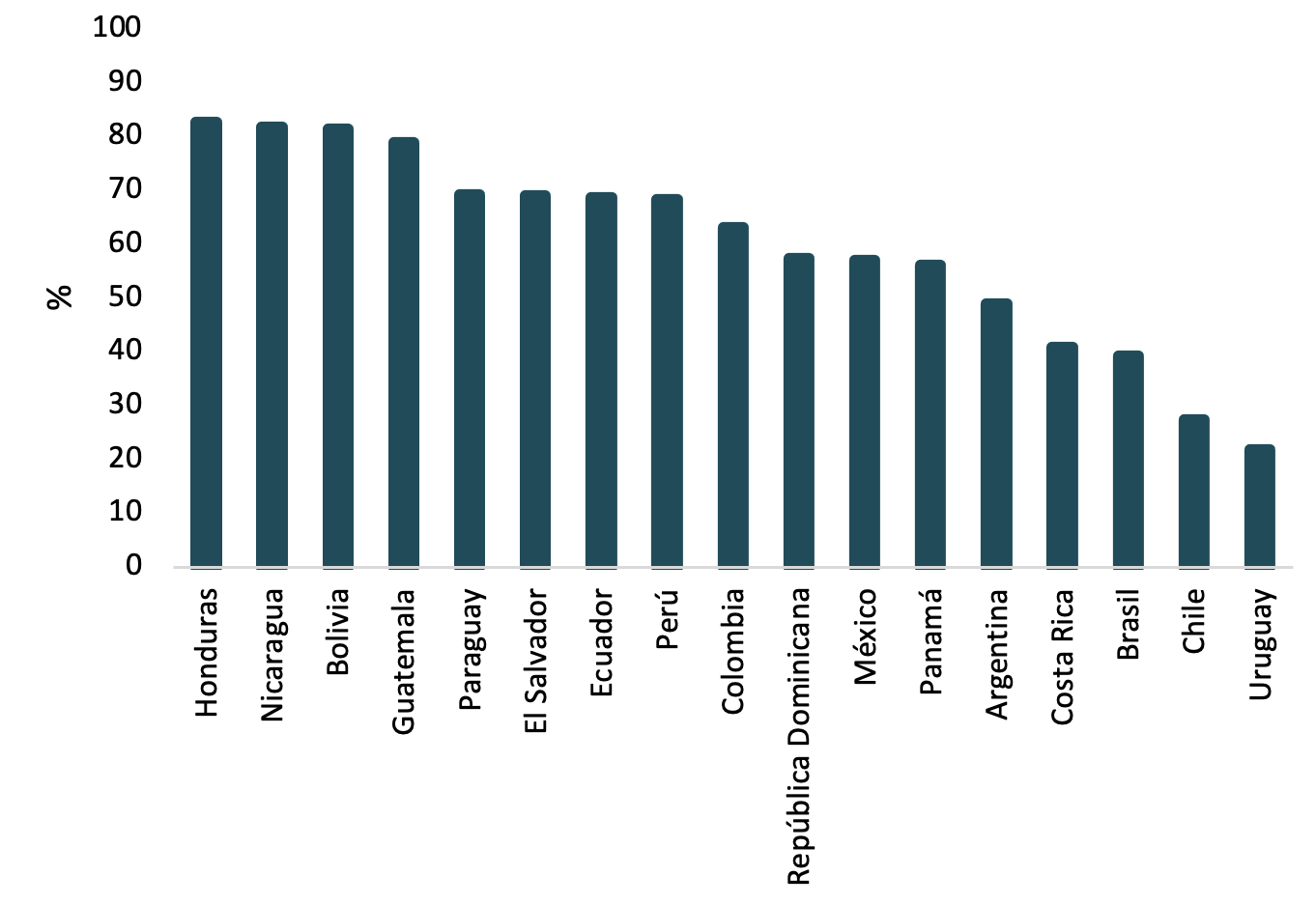
Fuente: ILOSTAT
Escapar de la trampa de estancamiento
Por supuesto, un horizonte oscuro en el crecimiento económico no es inevitable. La región tiene un potencial increíble. Por ejemplo, contiene el 60 por ciento de las reservas mundiales de litio (un mineral clave para la transformación energética global) y se ha logrado un progreso significativo en la digitalización. Sumamente importante es que, independientemente de la orientación política, la mayoría de los países siguen comprometidos con mantener la estabilidad macroeconómica, que es una pieza fundamental para el crecimiento económico sostenido y equitativo. Sin embargo, para que la región pueda alcanzar su potencial, son necesarias mejoras significativas en la gobernabilidad. Estas mejoras requieren reformas difíciles, como las de los sistemas legislativos y judiciales, así como aquellas que mejoren la capacidad de ejecución del Estado. Hasta ahora, dichas reformas han resultado extremadamente difíciles de implementar en la mayoría de los países. La pregunta del millón es si se puede llegar a un consenso sobre las reformas necesarias en el contexto de economías altamente polarizadas. Sin duda, este es el desafío principal para América Latina.
LILIANA ROJAS-SUAREZ es Senior Fellow y directora de la Iniciativa para América Latina en el Centro para el Desarrollo Global (Center for Global Development)
Rights & Permissions
You may use and disseminate CGD’s publications under these conditions.





